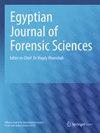世界不同地区的沃姆人骨骼频率分布是否反映了不同种群之间的遗传亲缘关系?
IF 1.3
Q3 MEDICINE, LEGAL
引用次数: 0
摘要
瘤骨或缝骨是颅骨缝内可能出现的额外的、形状不规则的骨碎片。这些骨骼可能是由于各种因素造成的,包括颅骨在早期发育阶段受到的机械压力(如人工颅骨变形),或由于遗传和环境影响。本研究通过比较缝骨在全球不同地区的出现频率,研究缝骨的潜在遗传基础。研究分析了 33 个颅骨系列,包括 2059 个颅骨,以评估来自澳大利亚土著、美拉尼西亚、东南亚、西伯利亚、欧洲和美洲原住民等地区的骨骼人群中冠状缝、鳞状缝、λ状缝和枕状缝的缝骨频率。使用史密斯的平均差异度量(MMD)计算了不同种群之间的生物学距离,并通过多维缩放将结果可视化。分析结果表明,高加索人和西伯利亚人有明显的种群集群。西伯利亚原住民聚居在一起,与 mtDNA 数据显示的贝加尔湖地区新石器时代居民的遗传根源相一致。此外,这些人群内部的分化与始祖效应和基因流动有关。值得注意的是,楚科奇的因纽特人和楚科奇人等基因相关群体与其他西伯利亚群体不同。相比之下,布里亚特人和蒙古人等西伯利亚南部人群的位置很接近,这与遗传数据一致。东南亚和非洲地区之间的分化更为微妙,它们的聚类在很大程度上是重叠的。然而,在某些情况下,人群之间也存在遗传联系。因此,澳大利亚人、美拉尼西亚人和巴布亚新几内亚人在多维尺度图上的位置很接近,两个非洲种群也是如此。研究结果初步表明,沃米安骨的表达可能与遗传因素有关,但这一假设还需要进一步的实证支持,特别是通过遗传研究。虽然遗传因素可能会影响 Wormian 骨的表达,但环境条件和病理过程也起着重要作用。可以说,虫骨有可能成为墓葬中亲缘关系分析的另一种工具;不过,其效用在很大程度上取决于其遗传影响的程度。如果未来的遗传学研究证实了大量的遗传因素,而且遗传因素在环境因素中占主导地位,那么这些骸骨在人类学和法医学分析中的应用将得到进一步的验证。本文章由计算机程序翻译,如有差异,请以英文原文为准。
Does the distribution of Wormian bone frequencies across different world regions reflect genetic affinity between populations?
Wormian, or sutural bones, are additional, irregularly shaped bone fragments that can occur within cranial sutures. These bones may arise due to various factors, including mechanical pressure on skull bones during early ontogenetic stages, such as during artificial cranial deformations, or due to genetic and environmental influences. This study investigates the potential genetic basis of sutural bones by comparing their frequencies across diverse global regions. It analyzed 33 craniological series, encompassing 2059 crania, to assess the frequency of sutural bones in the coronal, squamous, lambdoid, and occipitomastoid sutures among skeletal populations from regions including Aboriginal Australia, Melanesia, Southeast Asia, Siberia, Europe, and Native America. Biological distances between populations were calculated using Smith’s mean measure of divergence (MMD), with results visualized through multidimensional scaling. The analysis identified distinct clusters of Caucasian and Siberian populations. Siberian aboriginal populations are compactly grouped, consistent with mtDNA data indicating genetic roots dating back to the Neolithic inhabitants of the Lake Baikal region. Further, differentiation within these populations is linked to the founder effect and gene flow. Notably, genetically related groups like the Inuit and Chukchi of Chukotka differ from other Siberian groups. In contrast, southern Siberian populations, such as the Buryats and Mongols, are closely positioned, aligning with genetic data. The differentiation between Southeast Asian and African regions was subtler, with their clusters largely overlapping. Yet, genetic links between populations were observed in some cases. Thus, Australians, Melanesians, and Papua New Guineans were located close to each other on the multidimensional scaling map, as were two African populations. The findings tentatively suggest a potential genetic component in the expression of Wormian bones, although this hypothesis requires further empirical support, particularly through genetic studies. While genetic factors may influence the expression of Wormian bones, environmental conditions and pathological processes also play significant roles. It can be suggested that Wormian bones could potentially serve as an additional tool in kinship analysis within burials; however, their utility significantly depends on the extent of their genetic influence. If future genetic studies confirm a substantial genetic component and its dominance over environmental factors, the use of these bones in anthropological and forensic analyses would receive additional validation.
求助全文
通过发布文献求助,成功后即可免费获取论文全文。
去求助
来源期刊

Egyptian journal of forensic sciences
MEDICINE, LEGAL-
CiteScore
2.00
自引率
0.00%
发文量
51
审稿时长
17 weeks
期刊介绍:
Egyptian Journal of Forensic Sciences, the official publication of The International Association of Law and Forensic Sciences (IALFS), is an open access journal that publishes articles in the forensic sciences, pathology and clinical forensic medicine and its related specialities. The journal carries classic reviews, case studies, original research, hypotheses and learning points, offering critical analysis and scientific appraisal.
 求助内容:
求助内容: 应助结果提醒方式:
应助结果提醒方式:


